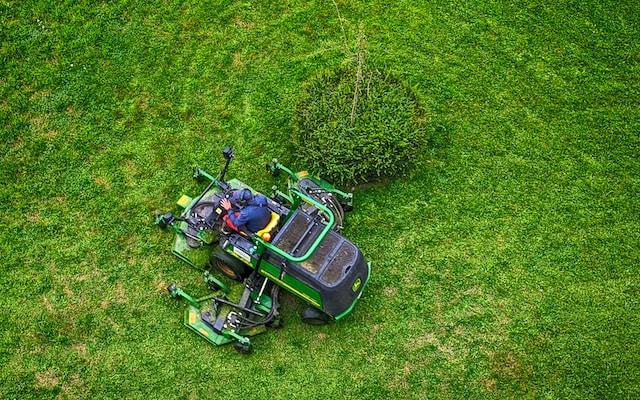Lawnmowers are great garden or outdoor tools for keeping lawns in good shape and cutting grass neatly. Like any other machine, Lawnmowers require regular care and maintenance, and one of the most critical maintenance tasks is removing the mower’s blade for sharpening or replacement.
Most blades on walk-behind lawnmowers are held in place by a threaded hex-headed bolt that screws into a blade adaptor on the engine’s driveshaft. To get your mower blade off the mower when it has to be sharpened or changed, turn out the blade retaining bolt.
Lawnmowers assist in the maintenance of lawns and the cutting of grass. Lawnmowers, like all equipment, require regular maintenance and care. To remove your blade for sharpening or replacement, unbolt the lock nut, which is often reverse-threaded, with a socket wrench.
Table of Contents
The Lawnmower Blades Are Not Reverse Threaded
You most likely already adore your lawnmower, which is equipped with blades to cut the grass blades and makes your lawn mowing labor much more accessible.
A traditional lawnmower often includes an internal combustion engine that serves as the lawn mower’s power source, nuts and bolts, and operating mechanisms designed to make cutting grass uniformly easier. So, it’s not rocket science to figure out how a lawnmower works.
The blades that cut the grass are arguably the fascinating element of lawnmowers. They’re also the ones that grab our attention the most when we look at a working lawnmower.
So, it’s understandable that the blades have piqued the interest of prompting many theories regarding the blades, their orientation, and their integration with the internal combustion engine. However, these have been crucial in determining the correct type of lawnmower according to their blades.
Pay Attention To The Blades Fitting
Pay attention to how the blade fits into the blade adapter on the engine shaft, which side of the blade faces up toward the mower deck, and which order the blade tensioning washers are inserted on the blade holding bolt when you undo the blade bolt.
Ensure to replace the washers in the correct order and insert the replacement blade into the blade adapter with the correct side facing up. Tighten the blade retaining or the torque amount provided in your mower manual by rotating it to the right or clockwise.
The Working Process Of Lawnmower Blades
Lawnmower blades, which are responsible for mowing the grass smoothly, are probably one of the fascinating characteristics. Furthermore, when purchasing equipment or considering a working lawnmower, these blades are the most prominent aspect that attracts our attention.
That’s why it’s easy to see why blades are so vital and why they’ve become such a hot topic. There are various theories about the blades and why their integration with the internal combustion engine has become so important in distinguishing the numerous types of lawn mowers available.
The lawnmower simply works by rotating the blade’s center in the opposite direction of regular cutting rotation. A fastening nut has been provided expressly for this purpose. It’s also worth noting that loosening is done with the right-hand thread in a clockwise direction while tightening with the left-hand thread in a counter-clockwise manner.
How To Remove And Install The Blades?
It’s critical to keep a blade level while removing it for maintenance, sharpening, or replacement. To ensure that the blade is level, most lawnmowers have a metal plate above it. The blade will not cut your grass if you install it upside down.
The lawnmower blade should be replaced every two to three years, depending on the size of your yard. Sharpen the blade with a handheld rotary tool with a grinding stone attachment. There are still several elements to consider to complete the procedure quickly and correctly. This occurs more frequently than you might expect.
Consider The Safety Parameters
Before removing the blade, it’s a good idea to remove the spark plug wire. Blade-lock gadgets are also available on some lawnmowers, which help keep the blade in place while removing and reinstalling it. The blade lock not only prevents the blade from moving while you spin the lock nut.
Moreover, it also prevents the engine from starting while you’re working on it.
Remember The Blades Position
Remember to keep track of which side of the blade is facing down. It’s critical to reinstall the blade in the same place from where it was removed especially for an inexperienced person. You may need to use some force to break the bolt loose, but be careful not to slide and cut your hand.
You can also use a bar breaker to generate more force while loosening the bolt safely.
Clean The Mower From Inside Or Outside
This step is optional, but after removing the blade, scrape the underside of the mowing deck clean to remove all caked-on debris and grass. However, you can also use professional cleaning tools to achieve the best cleaning results for your mower.
Final Verdict
Finally, make sure that just the right side of the replacement blade faces up when inserting it into the blade adapter. Also, make sure that the washers are replaced in the correct order.
Hopefully, this article will help you to get all the information about the threaded blades of lawnmowers. Now, it’s your turn to check the lawnmower blades for cleaning or any other maintenance purpose.





